Monday 1 June 1942
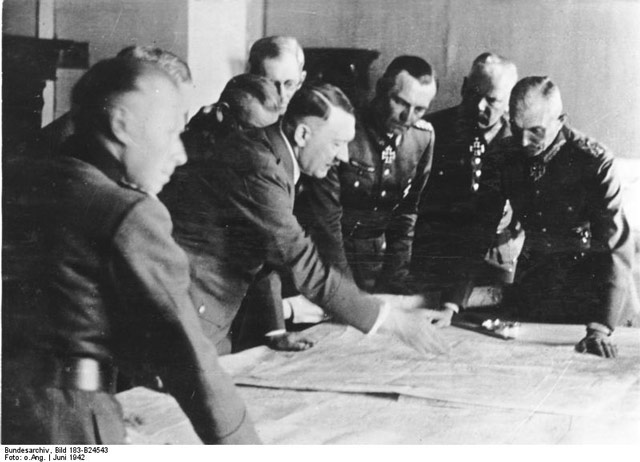 |
| Hitler at Poltava, 1 June 1942. From left to right: Lieutenant General Adolf Ernst Heusinger, General of the Infantry von Sodenstern, Colonel General Max Freiherr von Weichs, Adolf Hitler, General of the Panzer Force Friedrich Paulus, Colonel General Eberhard von Mackensen and Field Marshal Feodor von Bock. Federal Archive Image 183-B24543. |
Battle of the Pacific: On 1 June 1942, a Japanese invasion force departs from Kashiwabara on Paramushiru Island in the Kurile Islands heading for Kiska Island in the Aleutians. Meanwhile, the US Navy sends Task Force 8.6 centered around the light cruiser USS Nashville (CL-43) to patrol 400 miles (741 km) south of Kodiak Island. The US 11th Air Force now has 12 P-40s, six B-26 bombers, and a B-17E at Otter Point on Umnak Island.
Pursuant to Admiral Nimitz's orders, aircraft carrier Saratoga sails from San Diego for Pearl Harbor following repair of torpedo damage suffered on 11 January 1942 and some modernization. It carries 14 Wildcats of VF-2 Detachment and 23 Dauntlesses of VS-3, along with four Wildcats, 43 Dauntlesses, and 14 Avengers as cargo. The cargo aircraft are carried as future replacements for aircraft expected to be lost at Midway Island by carriers Enterprise, Hornet, and Yorktown.
Five Japanese submarines (I-21, I-22, I-24, I-27, and I-29) lie off Port Hacking, Australia, waiting for the crewmen of the mini-submarines that attacks Sydney Harbour on 31 May to reach their rendezvous point. The men never arrive, having all been killed either during the attack or afterward.
The US Fifth Air Force sends B-17s to attack the Japanese base at Rabaul, while others raid Lae and Salamaua, New Guinea.
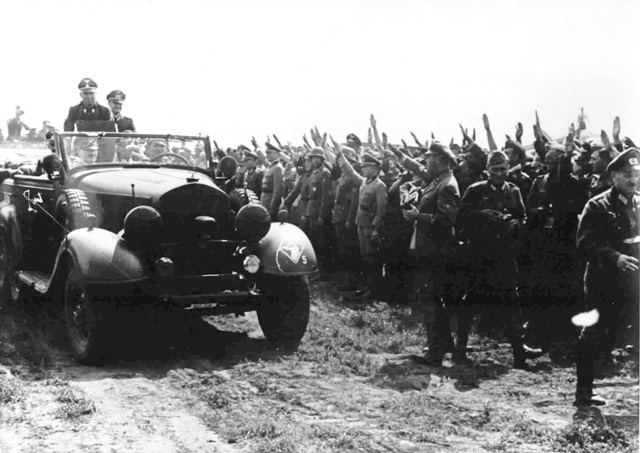 |
| Hitler driving from the airfield to his meeting with the leaders of Army Group South in Poltava, Ukraine, 1 June 1942. |
Battle of the Indian Ocean: Following their successful mini-sub attack on the British fleet at Diego Suarez, Madagascar, two Japanese sailors (Lt Akieda Saburo and PO1C Takemoto Masami) have abandoned their mini-sub at Nosy Antalikely (Antali Keli) islet. Having gotten to the mainland on the boat of some friendly locals, they are proceeding on foot to the pickup point at Cape Amber. Hungry, they stop at a village, Anijabe village, to buy some food. They obtain the food from the friendly locals, but one of them contacts the British in hopes of getting a reward.
Japanese submarine I-10 launches its "Glen" seaplane for a reconnaissance mission over Diego Suarez, Madagascar. Even though this is the third straight day of such flights, the British do not notice it.
The US 10th Air Force raids the Rangoon dockyards with five bombers. The bomber crews claim to sink one tanker and damage another.
 |
| Adolf Hitler, center, greets soldiers after getting off of his Focke Wulf Fw 200 Kondor at Poltava airfield, 1 June 1942. |
Eastern Front: Adolf Hitler makes a rare visit to Army Group Center headquarters at Poltava in the Reichskommissariat Ukraine. He is there to discuss the upcoming Case Blue with Field Marshal Fedor von Bock. Hitler flies in at 9 a.m. and is gone by noon. Afterward, everyone is a little mystified why he visited, but Hitler shows a bit of wanderlust in early June 1942, flying to Poltava, then to Finnland to wish Marshal Mannerheim a happy 75th birthday, and then down to Berchtesgaden for a holiday. This is the first of Hitler's two visits to Poltava, the second being on 3 July.
These visits accomplish nothing that could not also be done via simple teletype messages and phone calls. However, they serve Hitler's purposes in terms of reminding the generals and soldiers at the front who is really in charge. They also serve as good propaganda tools to show the same thing to the German public. Hitler fully expects Case Blau to be a resounding victory and the final German triumph over the USSR, so he wants to be seen prominently at the point of its inception.
At Sevastopol, General von Manstein's 11th Army bombards the Soviet holdouts throughout the day. He is preparing to finally take the port. The Red Army troops know they have no hope of relief and Stalin has not authorized a withdrawal using ships.
The action is heating up in the air over Sevastopol, too. II./JG 77's Lt. Ludwig-Wilhelm Burckhardt is shot down near enemy lines while flying an escort mission for Generaloberst Wolfram Freiherr von Richthofen's Fiesler Storch. He crash-lands near the Soviet lines, gets out of the plane, and runs for his life from advancing Soviet infantry. Burckhardt barely survives and makes it back to German lines but gets chewed out by his commander, Major Gordon Gollob, for not destroying his Bf 109 before leaving.
Back at Fuhrer Headquarters, General Franz Halder simply writes "Unchanged" in his war diary, adding "The mopping-up operation in the rear of Fourth Army [anti-partisan operation Hannover] is making good progress." Halder talks to General Hoth, the new commander of the 4th Panzer Army, about his role in Case Blue.
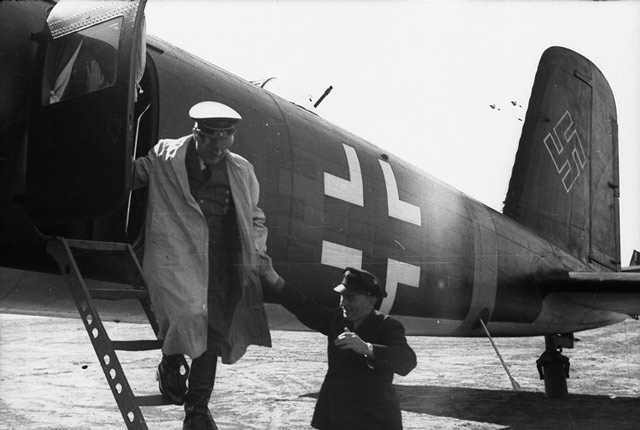 |
| Adolf Hitler exits his Focke-Wulf 200 in Poltava, Ukraine, 1 June 1942. |
European Air Operations: German flak batteries at Ostend down an RAF Spitfire. The Belgian pilot survives two days and three nights in his dinghy before being picked up by the Germans and imprisoned.
RAF Bomber Command takes a rest after two major raids on consecutive nights, one against Cologne and the other over Essen. It considers the Cologne raid a success although the RAF lost 40 bombers. The Essen raid by 956 bombers, however, achieved little due to poor bombing accuracy.
Fires rage in Canterbury, England, after the latest "Baedeker Blitz" attack by the Luftwaffe.
Lt. Heinz-Wolfgang Schnaufer of NJG 1 gets his first victory during the Essen raid. He will become known as "The Night Ghost of St. Trond."
Battle of the Baltic: German 981-ton freighter Malmö hits a mine in the Drogden area of the Skagerrak and sinks in Øresund southwest of Malmö, Sweden. On 8 August 1942, a Danish salvage company raises it, brings it to Copenhagen, repairs it, and returns it to service. It survives the war.
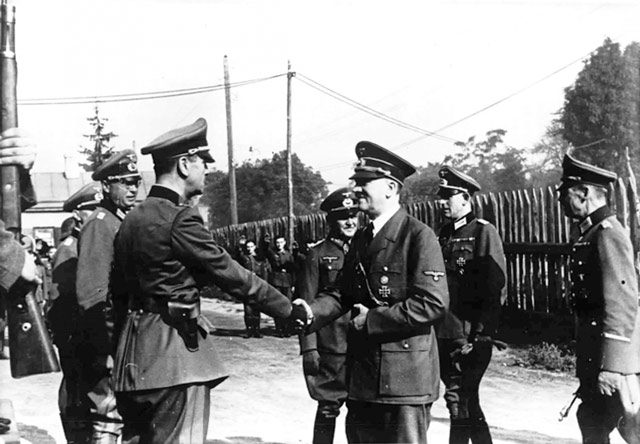 |
| Hitler arrives at the headquarters of Army Group South, 1 June 1942. |
Battle of the Atlantic: U-156 torpedoes and sinks 5970-ton Brazilian freighter Alegrete between St. Lucia and St. Vincent. The attack is made after dark at 23:51, making the (neutral) Brazilian flag difficult to see. The crew quickly abandons ship and the U-boat uses its deck gun to send it under by 03:00 on the 2nd. All 64 on the freighter survive, with three lifeboats making landfall in Trinidad and Venezuela and the fourth being rescued by USS Tarbell (DD 142).
U-158 (Kptlt. Erwin Rostin), on its second patrol out of Lorient, torpedoes and sinks 5686-ton US freighter Knoxville City near the Isle of Pines and 50 miles southeast of Cape Corrientes, Cuba. This sinking is sometimes listed as having sunk early in the morning on 2 June. A torpedo strikes the engine room, killing two men instantly and stopping the ship. After an hour the ship is still afloat, so Rostin fires another torpedo that sinks it. Aside from the two men in the engine room, all 53 other crewmen survive. The crew's story is a little unusual because a Brazilian freighter, Jamaica, stops and asks the men in the boats if they want to be rescued, but they decline because they fear that this ship will be torpedoed, too. They ultimately make landfall in La Calina, Cuba, after 48 hours.
U-106 (Kptlt. Hermann Rasch), on its sixth patrol out of Lorient, sinks 2689-ton US freighter Hampton Roads northwest of Cape San Antonio, Cuba. Rasch fires two warning shots with his deck gun, causing the freighter to stop. He waits for the crew to disembark, then fires one torpedo that sinks the ship. Five men remain on board and perish, but the other 23 men take to the boats and are picked up seven hours later by Alcoa Pathfinder.
U-404 (Kptlt. Otto von Bülow), on its third patrol out of Brest, torpedoes and sinks 5492-ton US freighter West Notus 320 miles east of Cape Hatteras, North Carolina. The U-boat chases the ship for two hours and 45 minutes, using its deck gun and scoring about 20 hits in 55 shots. The crew is unable to send a distress call because one of the first shells destroys the radio. Finally, one of the shots disables the steering, causing the ship to sail in circles. The crew abandons ship after firing some rounds with a machine gun that causes minor damage to the U-boat. The U-boat then surfaces, questions the men, gives them some Perrier mineral water bottles, and directs them to Cape Hatteras. The burning freighter, meanwhile, takes a long time to sink, so in an unusual move, von Bülow sends a party on board to plant scuttling charges. There are four dead and 36 survivors, who are picked up after a couple of days by two separate freighters (Greek Constantinos H. and Swiss Saentis).
U-566 (Kptlt. Dietrich Borchert), on its fifth patrol out of Brest, torpedoes and later uses gunfire to sink 9512-ton British freighter Westmoreland northeast of Bermuda 240 miles northeast of Bermuda. The ship takes a long time to sink, and remains afloat even after a coup de grâce torpedo is used, so Borchert surfaces and uses the deck gun to sink it after a five-hour ordeal. There are three dead and 65 survivors, who are picked up by two different freighters (Canadian Cathcart and U.S. Henry R. Mallory). This is U-566's only victory on this patrol.
Some sources place the sinking of 4536-ton Panamian freighter Bushranger today by U-107, but others do so on 31 May 1942, so I covered it there.
Luftwaffe Junkers Ju 87 Stuka bombers sink 6850-ton British freighter Empire Starlight in Murmansk Harbor. The Soviets refloat and repair it in 1945, renaming the freighter Murmansk. The planes also sink 235-ton Soviet freighter Subbotnik in the harbor, with eight dead.
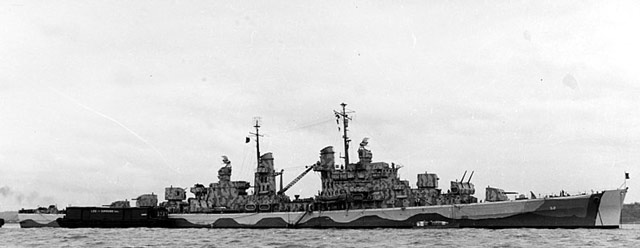 | ||
| The U.S. Navy light cruiser USS Juneau (CL-52). "Photographed off New York City, 1 June 1942. She has a barge alongside her starboard quarter. Her superstructure retains its original camouflage scheme, but her hull has been repainted to a different pattern." Juneau will be sunk on 13 November 1942 at the Naval Battle of Guadalcanal with the loss of 687, including the five Sullivan brothers. Naval History & Heritage Command 19-N-31264. |
Battle of the Mediterranean: Following heavy Stuka attacks on British defenders of the 150th Infantry Brigade at the Sidi Muftah box (Got el Ualeb, due west of Tobruk), German soldiers of the Afrika Korps resume their attack west against them that began on the 31st of May. The British Eighth Army attempts to relieve the embattled soldiers, without success. Fierce fighting continues throughout the day into the early afternoon, when the last British soldiers surrender. The Germans claim 3000 prisoners, the destruction of 101 tanks and armored cars, and the capture or destruction of 124 artillery pieces.
This enables the Germans to make contact with the Italian X Corps, advancing through the minefield from the west. This Axis victory clears two desperately needed pathways through the British minefields to the west so that supplies can be trucked in by the Italian Ariete and Trieste divisions.
Spy Stuff: The Wehrmacht begins a secret disinformation campaign, Operation Kreml (Kremlin). Working on the assumption that the Red Army has sources within the German army, Operation Kreml involves a phony plan by Army Group Center to mount a large-scale offensive to capture Moscow. The plan is put in motion today with the Army Group's distribution down to the regimental level of sealed maps of Moscow with instructions not to open them until 10 June, when meetings to discuss the offensive will be held. In fact, the only Wehrmacht offensive planned for the summer is the one in the south, Case Blau. Kreml is a classic misdirection counterintelligence operation.
 |
| A photo of Hermann Goering in the 1 June 1942 issue of Time Magazine. |
German Military: Generals Hermann Hoth of 17th Army and Richard Ruoff of 4th Panzer Army switch commands. Hoth is considered a top panzer general is tasked with preparing the 4th Panzer Army for its critical role in the upcoming Case Blue offensive into southern USSR toward Stalingrad.
Oblt. Heinrich Kraft of 8./JG 51 becomes Gruppenkommandeur of I./JG 51.
US Military: Headquarters, United States Army Northern Ireland Force and Headquarters, V Corps (both commanded by MG Hartle) transfer from Wilmont House to Lurgan. Meanwhile, the Headquarters of Northern Ireland Base Command (Provisional) is activated at Wilmont House under the command of BG Leroy P. Collins.
Brazilian Homefront: Companhia Vale do Rio Doce (CRVD) is founded in Itabira, Minas Gerais, Brazil. It is a metals and mining corporation that eventually evolves into Vale S.A., one of the most valuable companies in Latin America. It is also is controversial due to its impact on the environment and various accidents resulting in deaths and injuries.
 |
| Chinese leader Chiang Kai-shek on the cover of Time magazine, 1 June 1942. |
Holocaust: Carl Oberg officially takes up his post as Higher SS and Police Leader (Höherer SS-und Polizeiführer, HSSPF) "Frankreich" (France) with authority over German police and security forces in France, including the SD and the Gestapo. Oberg now is the ultimate authority in France for anti-partisan operations and Holocaust activities. He will earn the nickname "Butcher of Paris."
Reinhard Heydrich accompanied Oberg to his new post in France in early May (before the Heydrich assassination attack on 27 May). Already, even before his official installation, Oberg has instituted the policy of requiring Jews in Paris to wear a yellow badge. One of Oberg's defining characteristics will be ordering mass executions of hostages as reprisals for Resistance activities.
American Homefront: The Grand Coulee Dam, which has been under construction since the ceremonial driving of the first stake on 16 July 1933, opens on the Columbia River. The reservoir fills completely and the first waters overtop the spillway. Over 21,000 acres (85 square km) of land have been flooded
The dam's first generator has been in operation since January 1941. Getting the dam into full operation is a very slow and gradual process, with the last of its 18 generators not being switched on until 1950. The total cost of the dam in 2020 dollars: $2 billion.
Future History: Thomas Frank Mankiewicz is born in Los Angeles, California. The son of Joseph Mankiewicz and nephew of Herman Mankiewicz, both power players in Hollywood, Tom Mankiewicz goes on to become an American screenwriter, director, and producer of motion pictures and television. His most famous credits include "Superman: The Movie" (1978) and some James Bond films, including "Live and Let Die" (1973). Tom Mankiewicz was famous within Hollywood insider circles as a "script doctor" brought in to "fix" shaky movie scripts. He passes away in Los Angeles on 31 July 2010 from pancreatic cancer.
Cecil Randolph Hundley Jr. is born in Martinsville, Virginia. He becomes a top catcher, particularly defensively, in Major League Baseball from 1964-1977. He is most famous for playing with the Chicago Cubs. His son, Todd, also becomes a Major Leaguer. Hundley originated the idea of baseball "fantasy camps," where fans get to play with former pros. He apparently still operates some as of this writing in 2021.
Fernando Atzori is born in Ales, Province of Oristano, Italy. He goes on to become a champion boxer before retiring in 1975. He passes away on 9 November 2020.
 |
| Life magazine, 1 June 1942, with actress Hedy Lamarr on the cover. |
May 1942
2021
No comments:
Post a Comment